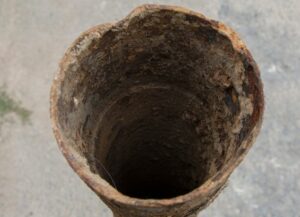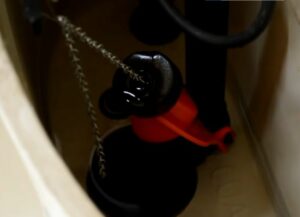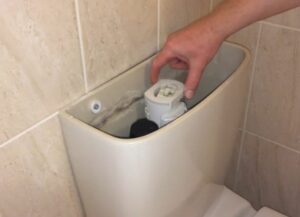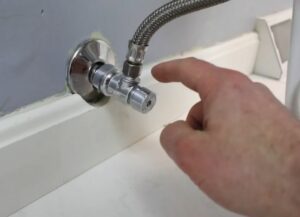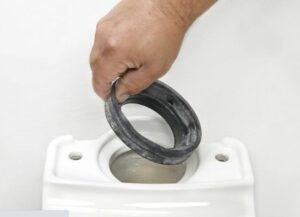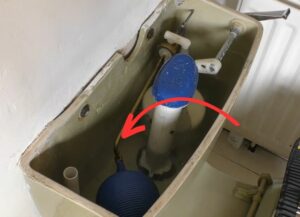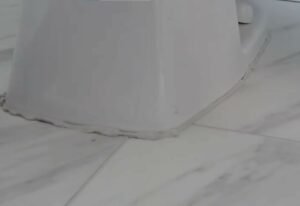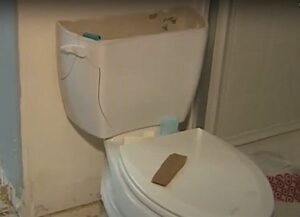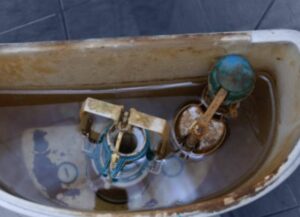
Have you ever walked into your bathroom only to find a mini flood around your toilet? It’s an unpleasant and stressful experience, but the good news is that many toilet leaks are easy to identify and fix — without always needing to call a plumber. A small toilet leak can make your entire bathroom messy, damage flooring, and waste gallons of water if not addressed quickly. Understanding the Most Common Toilet Leaks can help homeowners detect problems early and avoid costly repairs.
Common Causes of Toilet Leaks:
- ✅ Flapper Valve Leak
- ✅ Fill Valve Leak
- ✅ Overflow Tube Leak
- ✅ Tank-to-Bowl Gasket Leak
- ✅ Leak at the Base of the Toilet
- ✅ Loose Supply Line Connection
- ✅ Cracked Toilet Bowl or Tank
- ✅ Float Maladjustment
- ✅ Wax Ring Failure
- ✅ Faulty Shut-Off Valve
Let’s go over the most frequent problems and how to handle them.
1. Rust or Corroded Toilet Pipes
Over time, toilet pipes — especially those made from metal like iron or copper — can corrode or develop small cracks. These cracks can lead to leaks that result in discolored or dirty water pooling around the base of the toilet.
🔧 Solution:
- Metal Pipes (Copper, Galvanized Iron): Typically last over 50 years but should be checked for signs of rust or leakage.
- PVC Pipes: Last around 25–50 years but can become brittle and crack.
If you notice rust, leaks, or dirty water coming from the pipes, it’s time to replace the damaged section with new, durable piping material.
2. Worn-Out Toilet Flapper
The toilet flapper is a rubber valve inside the tank that opens when you flush and seals the tank afterward. Over time, the toilet flapper can degrade, warp, or crack, causing water to leak slowly into the bowl — wasting water and affecting flush performance.
🔧 Solution:
Replace the faulty flapper using the following steps:
- Turn off the water supply using the shut-off valve behind the toilet.
- Flush the toilet and hold down the handle to empty the tank.
- Detach the flapper chain from the flush lever.
- Unclip and remove the old flapper from the flush valve.
- Wipe the valve seat with tissue or a cloth to remove debris.
- Install a new flapper and reconnect the chain.
- Turn the water supply back on and test the flush.
Tip: Always choose a flapper compatible with your toilet model for a proper seal.
3. Flush Valve Assembly Misadjustment
Sometimes a toilet leak is hard to pinpoint. If you find water pooling but can’t trace the source, it could be due to a misaligned or damaged flush valve assembly inside the tank. This internal part controls how water flows from the tank to the bowl and can be tricky to inspect.
🔧 Solution:
- Remove the tank lid and inspect the flush valve area.
- If the flapper is worn, replace flapper along with the flush valve seal.
- For easier repair, use a flush valve repair kit that typically includes:
- A new flapper
- A flush valve seat
- A sealant ring
These kits eliminate the need to buy parts separately and make the repair process more efficient.
4. Cracked Water Supply Line
The water supply line carries water from your home’s plumbing to the toilet tank. When it cracks or loosens, water starts leaking onto the floor. If left unchecked, this can result in a flooded bathroom.
💡 Solution:
- Option 1: Hire a plumber to professionally replace the supply line.
- Option 2: DIY Fix – If you’re confident in your plumbing skills, turn off the water supply and carefully remove the old line. Replace it with a new, compatible hose and tighten the connections — but do not overtighten, as that can crack fittings or damage the toilet base.
5. Loose Tank-to-Bowl Connection (Two-Piece Toilets)
In two-piece toilets, the tank and bowl are connected using bolts and gaskets. If these components become loose or misaligned, leaks can occur between the tank and bowl or around the base of the toilet.
Note: This issue does not occur in one-piece toilets.
💡 Solution:
- Check all bolts connecting the tank to the bowl.
- Tighten loose bolts gently — avoid overtightening to prevent cracking the porcelain.
- Inspect for visible cracks in the bowl or tank. If found, replace the damaged component.
- Replace the tank-to-bowl gasket if it’s worn or deformed.
6. Faulty or Broken Float Assembly
The float ball or float cup assembly controls the water level in the toilet tank and stops the water from overflowing. If it’s incorrectly adjusted, stuck, or damaged, the tank may overfill, causing water to spill into the overflow tube or leak from the tank.
💡 Solution:
- Turn off the water supply.
- Flush the toilet to empty the tank.
- Inspect the float ball or float cup. If it doesn’t move freely or is damaged, it needs replacement.
- You can also manually test the fill valve by moving the float up and down — if the valve doesn’t respond properly, replace the entire float assembly or fill valve.
7. Loose Wax Ring Seal at the Toilet Base
A wax ring seals the toilet base to the drain pipe. Over time, it can dry out, become loose, or deteriorate, causing leaks from the bottom of the toilet, especially after flushing.
💡 Solution:
- If water is pooling around the base, remove the toilet by unscrewing the floor bolts.
- Scrape off the old wax ring and install a new one.
- Re-seat the toilet firmly but evenly, and tighten the bolts without overdoing it.
- A wax-free toilet seal is also an option for easier installation and long-term reliability.
8. Cracked or Damaged Toilet Tank
The toilet tank stores water for flushing. Cracks — whether from impact or long-term wear — can cause slow leaks or even significant flooding over time.
💡 Solution:
- Minor hairline cracks may be temporarily patched with waterproof epoxy.
- For serious or spreading cracks, replacing the tank is the safest and most permanent solution.
- Always choose reliable brands like Parryware, Hindware Homes, or Somany Ceramics for quality and durability.
9. Rusted or Corroded Fill Valve
Even if everything else seems fine, a rusted fill valve can be the hidden cause of toilet leaks. Rust or mineral buildup can cause the valve to malfunction, letting water continuously flow or drip.
💡 Solution:
- Turn off the water supply.
- Disconnect the water supply line from the bottom of the tank.
- Remove the old fill valve by unscrewing it.
- Insert a new fill valve, adjusting it to the correct height.
- Reattach the water line and tighten it just enough — not excessively.
- Refill the tank and test for proper function. Finally, replace the tank lid.
Frequently Asked Questions
1. What should I do when I identify a toilet leak?
If you detect a toilet leak, take immediate action to prevent water damage and further issues:
- 🧼 Turn off the water supply to the toilet.
- 🚽 Empty the toilet tank by flushing.
- 🔧 Tighten any loose nuts and bolts.
- 🧰 Replace the tank-to-bowl gasket if needed.
- 💺 If the toilet seat is cracked or broken, replace it.
2. What are the different types of toilet leaks?
Toilet leaks can occur in several areas. The most common sources include:
- 🚿 Water supply line – may leak due to loose connections or worn washers.
- 🧻 Wax ring – a broken or old wax ring can cause leaks around the base.
- 🚽 Flapper valve – if worn out, it causes water to continuously run from the tank to the bowl.
Using high-quality replacement parts from trusted brands can help reduce the frequency of leaks.
3. How can I stop my toilet from leaking?
To prevent toilet leaks:
- Regularly check and replace old or rusty bolts and nuts.
- Inspect the flapper, fill valve, and wax ring for wear.
- Ensure all seals and connections are tight.
- Use plumber’s tape when needed to secure connections.
- Don’t overtighten bolts, as this can crack porcelain parts.
4. Is it necessary to call a plumber for a toilet leak?
Not always. Minor leaks, such as a loose bolt or worn flapper, can be fixed with DIY methods. However, you should call a licensed plumber if:
- You see water pooling around the toilet base.
- There’s a leak you can’t identify.
- You hear continuous running water even after repairs.
- There’s visible mold or structural damage around the toilet.
5. How can I tell if the toilet is leaking from the base?
You may have a base leak if:
- There’s a water puddle at the bottom of the toilet.
- You notice bad odors or mold growth.
- The floor around the toilet feels soft or discolored.
In most cases, this points to a failing wax ring that needs replacement.
6. How long do toilet bolts and gaskets typically last?
Toilet bolts and gaskets usually last between 5–10 years, depending on usage and water quality. Rust, mineral buildup, or poor-quality materials can reduce their lifespan. Replacing them with corrosion-resistant, high-quality parts ensures better durability.
7. Can a leaking toilet increase my water bill?
Absolutely. Even a small leak—like a faulty flapper—can waste hundreds of gallons of water per month, significantly increasing your water bill. Regular inspections help avoid such costly issues.
8. What tools do I need to fix a toilet leak?
Common tools for toilet leak repair include:
- Adjustable wrench
- Screwdriver
- Plumber’s tape
- Replacement nuts, bolts, washers, or gaskets
- Bucket and towels for cleanup
9. How do I know if the flapper is causing the leak?
To test the flapper:
- Put a few drops of food coloring in the tank.
- Wait 15–30 minutes without flushing.
- If the color appears in the bowl, your flapper is leaking and needs replacement.
Conclusion
Toilet leaks can be a real nightmare for any homeowner. If not addressed promptly, they can lead to water damage, increased utility bills, and even mold growth. That’s why it’s crucial to take preventive measures to avoid toilet leaks in the first place.
As a responsible and conscious user, make sure to regularly clean your toilet, inspect all components, and replace worn-out bolts, nuts, and seals with new ones. Routine maintenance not only ensures a leak-free experience but also extends the life of your toilet.
However, if you notice any signs of a toilet leak—such as water pooling around the base, a constantly running tank, or a drop in water pressure—don’t delay. Contact a licensed plumber immediately to prevent the problem from escalating.
Remember, early detection and timely repair are key to maintaining a fully functional and efficient toilet system. By identifying and fixing the Most Common Toilet Leaks promptly, you can maintain efficiency, save water, and extend the life of your toilet.
We are really lucky to have a hard-working, multi-skilled plumber on our team. Collin D. Gallegos, a professional plumber who has worked with us since 2012, is an expert in vent, septic, and drainage systems. He is a Certified Master Plumber and has worked on various commercial plumbing projects. He usually helps our readers resolve plumbing and pipe-related issues with a proper DIY troubleshooting and repair guide.
